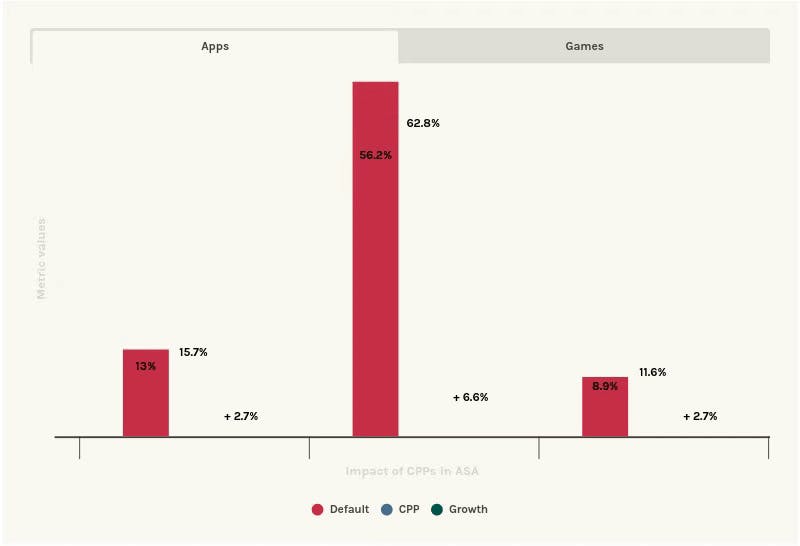
2025年のApple Ads完全ガイド
Apple Adsは、App Store上でのアプリの可視性を戦略的に高め、高い意図を持つユーザーと接続(する)し、質の高いインストールを促進するための方法を提供します。様々な広告配置を理解し、明確な目標に基づいてキャンペーンを構築し、カスタム商品ページなどのツールを活用することで、広告戦略を最適化し、広告費用対効果(ROAS)を最大化できます。
Apple Adsを初めて使用する場合でも、アプローチを洗練させたい場合でも、このガイドはキャンペーンを最大限に活用するための重要な洞察を提供します。
主なポイント
- Apple Adsの4つの広告配置(検索結果、検索タブ、Todayタブ、商品ページ)を活用して、発見の異なる段階にあるユーザーと接続(する)し、リーチを最大化します。
- 検索キャンペーンを明確な目標に基づいて整理し、ブランド、競合他社、カテゴリー、ディスカバリーキャンペーンに分割して、目的に合わせ最適化を効率化します。
- 完全一致と幅広い一致を組み合わせて、精度と発見のバランスを取ります。キーワード発見専用のキャンペーンまたは広告グループで検索マッチをオンにします。否定的なキーワードを追加して、無関係なトラフィックをフィルタリングし、効率を向上させます。
- 入札 = 目標獲得単価(CPA)× コンバージョン率(CVR)の公式を使用して入札を最適化し、コスト効率と可視性のバランスを取ります。
- カスタム商品ページにユーザーを誘導することで、ユーザーの意図に合わせて広告をカスタマイズします。このアプローチは関連性とコンバージョンを大幅に改善できます。
Apple Search Ads Manager
効果的なキャンペーンを作成し、パフォーマンスを監視し、Apple検索広告を強化する新しい機会をAppTweakで直接見つけることができます。
Apple Adsとは何ですか?
Apple Adsは、App Store上でアプリの発見を支援する有料広告プラットフォームです。主要な場所(検索結果の上部、Todayタブ、検索タブ、または他のアプリの商品ページ)で、適切なタイミングでお客様にリーチし、アプリを特集することができます。これらの配置により、明確な意図を持って検索する段階から何か新しいものを気軽に閲覧する段階まで、ユーザーの旅の異なる段階で潜在的なユーザーと接続(する)する複数の機会が提供されます。Apple Adsが提供するインテリジェントな技術、ターゲティングオプション、予算管理、洞察を活用することで、より多くのダウンロード数を促進し、ユーザー獲得を改善し、アプリを効果的に成長させることができます。
アプリプロモーションにApple Adsを使用する理由は?
Apple Adsは、Singularのモバイルインデックスレポートによると、モバイルユーザー獲得広告ネットワークのトップ3に入っており、可視性を高め質の高いダウンロード数を促進したいアプリマーケターにとって必須のツールとなっています。
- 広範囲のリーチ:毎週6億5000万人以上の人々がアプリを発見しダウンロードするためにApp Storeを訪れています。
- 高いユーザー意図:App Storeでの検索直後にすべてのアプリ ダウンロード数の約65%が発生しているため、Apple Adsはダウンロードの意図が高いユーザーにリーチするのに役立ちます。この強い意図は、プラットフォームの57%の平均コンバージョン率に反映されており(出典:AppTweak)、Apple Adsが検索をダウンロード数に変換する効果的な方法であることを示しています。
- グローバルな規模:Apple Adsは91の地域と国で利用可能であり、グローバルな視聴者にリーチする最も簡単で迅速な方法の1つです。
- カスタマイズされた体験:カスタム商品ページを使用すると、異なる地域、ユーザーの好み、検索行動に合わせて広告を適応させることができ、より関連性の高い体験を提供し、ROIを最大化するのに役立ちます。
- ASOとの相乗効果:ASOとApple Adsを組み合わせることで、強力な成長戦略が生まれます。Apple Adsは即時の可視性を生み出し、ASOを強化する洞察を提供します。
Apple Adsはどのように機能しますか?
シンプルで自動化されたアプローチを求めている場合でも、完全な制御とカスタマイズを好む場合でも、Apple Adsは2つのソリューションを提供しています:Apple Ads BasicとApple Ads Advanced。これらのオプション、配置、キャンペーンタイプ、ターゲティング機能を理解することで、目標に沿い、アプリの成長を最大化する戦略を立てることができます。
Apple Ads Basic vs Apple Ads Advanced
Apple Ads Basicはシンプルで使いやすい設計になっています。小規模ビジネスや個人開発者に最適です。アプリを選択し、ターゲット地域を選び、予算を設定するだけです。Appleが自動的に広告を作成し、関連する検索結果に広告を表示します。
Apple Ads Basicの仕組み:
- 自動マッチング: Appleは機械学習を使用して、アプリのメタデータに基づいて関連する検索に自動的に広告をマッチングします。キーワードを手動で管理する必要はありません。
- インストール単価(CPI)の設定: インストール1回あたりの最大支払額を設定し、コストをコントロールします。Appleはアプリの特性と競合他社のベンチマークに基づいて推奨最大CPIを提供しますが、予算と目標に合わせて調整できます。
Apple Ads Advancedは完全なコントロールと柔軟性を提供するように設計されており、マーケターや大規模チームに最適です。広告の表示場所を選択し、独自のキーワードを管理し、パフォーマンスを最適化するためにビッドをカスタマイズできます。
Apple Ads Advancedの仕組み:
- 複数の配置場所: 検索結果、Todayタブ、検索タブ、他のアプリの製品ページで広告を実行し、最大限の可視性を確保します。
- キーワード管理: アプリに関連する特定のキーワードを選択してビッドし、ターゲティングを完全にコントロールします。
- オーディエンスターゲティング: 人口統計、場所、デバイスタイプなどでオーディエンスを絞り込み、適切なユーザーにリーチします。
- カスタム製品ページ: カスタム製品ページを使用して、異なるオーディエンス、地域、またはキーワードに合わせた広告バリエーションを作成し、よりパーソナライズされた体験を提供します。
- 詳細なレポート: インプレッション、タップ、コンバージョン、タップ単価(CPT)などの包括的な指標にアクセスし、キャンペーンを最適化します。
Apple Adsの配置場所
Apple AdsはApp Store上で複数の広告配置を提供し、発見プロセスの異なる段階で潜在的なユーザーと接続(する)するのに役立ちます。各配置場所は固有の目的を果たし、バランスの取れたユーザー獲得戦略を立てることができます。
- 検索結果: 関連する検索クエリの上位に表示され、アプリを積極的に探しているユーザーをターゲットにします。ダウンロード数の65%以上が検索から直接来ているため、この配置は高い意図を持つユーザーにリーチするのに役立ちます。
- 検索タブ: ユーザーがクエリを入力する前に広告を表示します。この一等地は、検索プロセスの早い段階で注目を集め、ブランドの認知度を高めるのに役立ちます。
- Todayタブ: App StoreのフロントページにあたるTodayタブにアプリを表示します。ユーザーがApp Storeを開いたときに最初に目にするため、幅広い認知度と強い第一印象を作るのに理想的です。
- 製品ページ: あなたのアプリに関連する他のアプリの製品ページに広告を表示します。この配置は、類似のアプリを探索している熱心なユーザーにリーチし、ダウンロード数の可能性を高めます。

これらの配置場所を活用することで、ユーザーの旅のさまざまな地点でユーザーと出会い、アプリの可視性と成長を最大化するApple Ads戦略を調整できます。これらの中で、検索結果の配置は最も技術的で戦略的であり、キーワード管理、入札戦略、クリエイティブの最適化についてより深い理解が必要です。
Apple Adsキャンペーンタイプ
検索キャンペーンを特定の目的に基づいて構築することをお勧めします。ブランドを保護するか、新しいオーディエンスにリーチするか、未開拓の機会を発見するかにかかわらず、キャンペーンを効果的に整理することで、より良いターゲティング、予算管理、より簡単な入札管理が確保されます。以下は、目標に合わせた主要なキャンペーンタイプの内訳です:
- ブランドキャンペーン: あなたのアプリ名や会社に関連するキーワードをターゲットにすることで、ブランドを保護することに焦点を当てます。これにより、アプリを検索しているユーザーがあなたを最初に見つけ、競合他社があなたのトラフィックを奪うのを防ぎます。
- 競合他社キャンペーン: 競合他社アプリに関連するキーワードをターゲットにし、代替案を探しているユーザーにリーチします。これらのキャンペーンは競争が激しいため、より高額になる可能性がありますが、市場シェアを増やし、積極的に選択肢を比較しているユーザーを引き付けるのに効果的です。
- カテゴリーキャンペーン:アプリのカテゴリーや主要機能に関連する、幅広い非ブランドキーワードをターゲットにします。これにより、あなたのブランドを知らなくても、あなたのようなアプリに興味がある幅広い層にアピールできます。
- ディスカバリーキャンペーン:新しい関連キーワードを見つけ、リーチを拡大するためのキャンペーンです。これらのキャンペーンは、成長の機会を特定し、他のキャンペーンでは考えつかなかった検索の用語を発見するのに理想的です。
Apple Adsのオーディエンスターゲティングオプション
キャンペーンを設定する際、Apple Adsは最も関連性の高いユーザーにリーチするためのいくつかのオーディエンスターゲティングオプションを提供しています:
- デバイスタイプ:使用しているデバイス(例:iPhoneまたはiPad)に基づいてユーザーをターゲットにし、アプリの互換性とパフォーマンス目標に合わせます。
- 位置情報:特定の地域、国、または都市にフォーカスし、市場目標、季節のプロモーション、または発売戦略に合わせます。
- デモグラフィック:年齢と性別でオーディエンスを絞り込み、理想的な顧客プロファイルに合うユーザーにリーチします。
- 顧客タイプ:アプリとのユーザーの関係に基づいてターゲットを設定します:
- すべてのユーザー:アプリの見込み、以前の、および現在のお客様すべて。
- 新規ユーザー:まだアプリをダウンロードしていない人々。
- リターニングユーザー:以前にアプリをダウンロードしたことがある人々。広告を見る人々は、過去にアプリを持っていたが削除した可能性や、他のデバイスにダウンロードしている可能性、または現在デバイスに持っている可能性があります。
- あなたの他のアプリのユーザー:あなたが所有する他のアプリを使用している人々。
これらのオプションにより、カスタマイズされたキャンペーンを作成し、ターゲティングの精度を向上させ、広告費用対効果を最大化することができます。
Apple Adsのキーワードマッチタイプ
Apple Adsは2つのキーワードマッチタイプ—完全一致と広範一致—を提供し、検索用語があなたのキーワードにどれだけ近く一致する必要があるかを制御し、広告をトリガーするのに役立ちます。
- 完全一致:あなたのキーワードと正確に一致する、または単数・複数形や軽微なミススペルなどの近い変形を含む検索をターゲットにします。このマッチタイプは最高レベルの制御を提供し、あなたが定義したキーワードに対して広告が表示されるのを助けます。
- 広範一致:関連フレーズ、同義語、キーワードの変形を含む、より広範囲の検索用語に対して広告が表示されることを可能にします。広範一致は、より広いオーディエンスにリーチし、新しいキーワードの機会を発見するのに役立ちますが、無関係なトラフィックを避けるためにモニタリングが必要です。
また、検索マッチ機能を活用することもできます。これは、アプリのメタデータ、カテゴリー、関連するアプリに基づいて、関連する検索に自動的に広告をマッチングします。この機能は、手動入力なしで新しいキーワードを発見するのに最適ですが、無関係なインプレッションを避けるためにネガティブキーワードを追加する必要があるかもしれません。
Apple Ads 検索結果キャンペーンの構造化と設定方法
検索キャンペーンを実際に設定し構造化する実践的なステップに入りましょう。このセクションでは、あなたの目標に合わせ、アプリの成長を最大化するキャンペーンを設定するためのステップバイステップのガイドを提供します。
1. 目標別にキャンペーンを整理する
成功するApple Adsキャンペーンを設定する最初のステップは、目的を明確に定義することです。目標(ブランド、競合他社、カテゴリー、またはディスカバリー)別にキャンペーンを整理することで、集中力を維持し、予算を効果的に配分し、パフォーマンスをより効率的に最適化することができます。
2. キャンペーンパラメータを設定する
Apple Adsでキャンペーンを作成する際、以下のパラメータを定義する必要があります:
- 日予算:コストをコントロールし、一貫した広告の可視性を確保するために、1日の支出限度額を設定します。
- か国または地域:広告を実行したい市場を選択します。予算が許せば、各国や地域ごとに別のキャンペーンを作成するのが最善です。このアプローチにより、各市場のパフォーマンスに基づいて入札と予算を管理できます。
3. フォーカスされた広告グループを作成する
次のステップは、明確な広告グループでキャンペーンを構造化することです。広告グループは関連するキーワードをクラスター化するのに役立ち、広告がユーザーの検索に関連性を保つことを確保します。
例えば、fitness アプリのカテゴリーキャンペーンでは、「ワークアウト、」「栄養、」「減量」のアドグループを設定できます。各アドグループには、それらの検索用語に合わせた、焦点を絞ったキーワードセットと広告バリエーションを含める必要があります。

このようにキャンペーンを分類することで、詳細なレベルで入札、予算、パフォーマンスを管理できます。このアプローチにより、最適化が容易になり、広告の関連性が向上し、広告費用対効果を最大化するためのデータ主導の意思決定が確実に行えます。
各アドグループに対して、以下のパラメータを定義する必要があります:
- 広告グループターゲティング:各アドグループに対して、デバイスタイプ、場所、デモグラフィック、顧客タイプ(全て、新規または既存ユーザー)を含むオーディエンスターゲティングパラメータを定義します。
- 最大CPT入札額:支払う意思のある最大のコスト・パー・タップ(CPT)を設定します。
- CPA上限(オプション):コンバージョンあたりの支出を制限するためのコスト・パー・アクイジション(CPA)上限を指定します。最大CPT入札額は、次の式を使用してこの上限の影響を受けます:CPAの上限 x タップスルーコンバージョン率 = 入札上限
例:CPA上限が5ドルで、コンバージョン率が65%の場合、入札上限は3.25ドルになります。最大CPT入札額が4ドルに設定されていても、適用される入札額は3.25ドルになります。
4. キーワードマッチタイプを選択し、キーワードを選択する
Apple Adsはデフォルトで検索マッチに設定されており、アプリのメタデータに基づいて関連する検索に自動的に広告をマッチングします。これはディスカバリーキャンペーンに有用ですが、例えばブランド、カテゴリー、競合アプリキャンペーンで特定のキーワードをターゲットにしたい場合は、オフにすることをお勧めします。手動で選択する各キーワードに対して、適切なマッチタイプ(完全一致または広範囲一致)を選択できます。
適切なキーワードを選択することに加えて、ディスカバリーキャンペーンや広範囲一致を使用するキャンペーンで除外キーワードを使用して、関連性のない検索をフィルタリングすることが重要です。除外キーワードは、広告が最も関連性の高いオーディエンスにのみリーチするようにし、無駄な支出を削減するのに役立ちます。より細かい制御のためにアドグループレベルで除外キーワードを追加したり、キャンペーンレベルで全アドグループにわたって用語を除外したりできます。すべての除外キーワードは完全一致である必要があります。
5. 広告クリエイティブとカスタムプロダクトページを定義する
Apple Adsは、App Store Connectからアプリのメタデータ(アプリ名、アイコン、サブタイトル)を使用して自動的に広告を作成します。より適切なメッセージングのために、アドグループのキーワードの特定の意図に合わせて設計されたカスタムプロダクトページ(CPP)にユーザーを誘導できます。カスタムプロダクトページを使用すると、よりパーソナライズされた体験を提供することで、関連性が向上し、コンバージョン率が促進される可能性があります。
Apple Adsキャンペーンのキーワードを選択する方法
Apple Adsキャンペーンのキーワードを適切に選択することは、目標を達成し、広告の関連性を向上させ、質の高いダウンロード数を促進するために極めて重要です。ブランド、競合アプリ、カテゴリー、ディスカバリーの各キャンペーンタイプには、成功するための調整されたキーワード戦略が必要です。以下は、キャンペーンに最適なキーワードを調査し選択するためのヒントです:
- ブランドキャンペーン:アプリ名、ブランド名、一般的なミススペルを含む完全一致キーワードに焦点を当てます。AppTweakのようなツールは、ユーザーが頻繁に検索する変形やミススペルを特定するのに役立ち、包括的なブランドカバレッジを確保します。
- 競合他社キャンペーン:ブランドキャンペーンと同様に、主要な競合他社のアプリ名やブランド名、一般的なミススペルに関連する完全一致キーワードをターゲットにします。幅広い競合他社をターゲットにする場合は、それらを異なるアドグループにグループ化することを検討してください。この分類により、各競合アプリの入札額を調整でき、効率的な予算配分が可能になります。特定の競合他社に対するアプリの利点を強調するために、カスタムプロダクトページを使用して広告バリエーションを作成し、関連性を向上させることができます。
- カテゴリーキャンペーン:ユーザーの意図に基づいてキーワードをセグメント化し、各意図に合わせたアドグループを作成してより正確なターゲティングを行います。アプリのカテゴリー、特徴、機能を反映した一般的な非ブランドキーワードを使用します。例えば、瞑想アプリの場合、「ストレス解消、」「ガイド付き瞑想、」「呼吸法」などのキーワードをターゲットにします。関連性を維持しながら幅広い層にアプローチするため、高検索ボリュームのキーワードとロングテールバリエーションのバランスを取ります。広告の表示を正確にコントロールするには完全一致を使用します。
ネガティブキーワードのヒント:無駄な支出につながる可能性のある、過度に広範囲または無関係な用語を除外します。例えば、アプリの機能に関連しない一般的なフレーズなどです。
- ディスカバリーキャンペーン:部分一致キーワードと検索マッチを使用して、関連する検索用語に自動的に広告をマッチさせます。これにより、考慮していなかった検索用語を見つけることができます。これらのキャンペーンから高パフォーマンスのキーワードを特定したら、より手動でのコントロールと最適化された入札のために、ブランド、競合アプリ、またはカテゴリーキャンペーンに移行させます。2つの専用アドグループを作成する必要があります:
- 部分一致アドグループには、他の3つのキャンペーンタイプのすべてのキーワードが含まれますが、マッチタイプは部分一致に設定し、検索マッチはオフにします。
- 検索マッチアドグループにはキーワードを含めず、検索マッチをオンにして、関連するApp Store検索に対して広告を表示します。
ネガティブキーワードのヒント:同じ用語に入札し、取り組みが重複することを避けるため、ディスカバリーキャンペーンでは他のキャンペーンから完全一致キーワードをネガティブとして追加します。

Apple Adsの組み込みのキーワード推奨機能を使用して、キャンペーンに追加する新しいキーワードを素早く特定できます。ただし、より広範囲なキーワードリサーチと最適化には、AppTweakのCampaign Managerのようなプラットフォームを使用すると役立ちます。AppTweakは、高パフォーマンスのキーワードを見つけ、キャンペーンに簡単に追加するプロセスを効率化するために設計された12以上のキーワード選択ツールを提供しています。

Apple Adsキャンペーンの適切な入札額を定義する方法
Apple Adsキャンペーンの適切な入札額を定義することは、可視性とコスト効率のバランスを取ることです。キーワードの最適な入札額を設定するための実践的なステップは以下の通りです:
- メトリクスの確認:Apple Adsが提供する推定コストパータップ(CPT)と競合レベルを分析することから始めます。高意図または競争の激しいキーワードの場合、可視性を確保するためにより高い入札額が必要になる可能性があります。ニッチまたはロングテールキーワードの場合、低い入札額でも良好な結果を得られることがあります。
- 小規模なテストを実行してデータを収集:始めたばかりの場合は、異なる入札額で短期間のテストを実行し、キャンペーンを数日間実行させます。タップスルー率(TTR)、コンバージョン率(CVR)、獲得単価(CPA)などの主要指標を追跡します。このテストフェーズは、キーワードのパフォーマンスを理解し、正確な入札調整に必要なデータを提供するのに役立ちます。
- 入札式を使用:過去のデータがあれば、この簡単な式を使用して入札をガイドします:入札額 = 目標CPA × コンバージョン率(CVR)
例えば、目標CPAが5ドルで、CVRが20%(0.20)の場合、理想的な入札額は1ドルになります。
この式は、入札額が予算とパフォーマンス目標に合致するよう支援します。予算管理と実際のパフォーマンスデータを組み合わせているため、効果的です。目標獲得単価(CPA)は事前に定義された支出制限内に抑え、コンバージョン率(CVR)はキーワードがタップをインストールに変換する効果を反映します。
4. パフォーマンスに基づいて入札額をAdjust:キャンペーンのパフォーマンスを継続的にモニタリングします。キーワードのパフォーマンスが良好だが広告のインプレッション数が十分でない場合は、入札額を少し上げます。コストが高くコンバージョンが低い場合は、入札額を下げるかキーワード戦略を見直すことを検討します。
AppTweakのCampaign Managerのようなツールは、リアルタイムのデータとパフォーマンストレンドに基づいた自動入札提案で入札管理を簡素化できます。これにより、常に手動で調整することなく競争力を維持できます。

Apple Ads キャンペーンの入札を上げるタイミングについてのさらなるヒント。
カスタム 製品ページに基づく広告バリエーション
デフォルトの App Store 製品リストの代わりに、カスタム 製品ページに基づく広告バリエーションにユーザーを誘導することで、Apple Ads キャンペーンを最適化できます。カスタム 製品ページを使用すると、App Store 製品ページの異なるバージョンを作成でき、それぞれに固有のスクリーンショット、アプリ プレビュー、プロモーションテキストを含めることができます。戦略的に使用すると、検索 結果キャンペーンで広告バリエーションとして使用される カスタム 製品ページは、関連性を大幅に向上させ、コンバージョン率 を促進できます。

左:デフォルトの アプリ 製品ページ、右:庭の手入れのヒントとしての アプリ の使用を紹介する異なるスクリーンショットセットを表示する広告バリエーション。
カスタム 製品ページとは何ですか?
カスタム 製品ページを使用すると、特定のユーザーの意図や 検索 用語に合わせて、アプリ の異なる機能、利点、視覚的要素を強調できます。すべてのユーザーを同じ一般的な製品ページに誘導する代わりに、ニーズや期待に合わせたバリエーションに誘導できます。
アプリ ごとに最大35の カスタム 製品ページを作成でき、幅広い対象者、検索 用語、マーケティングキャンペーンをターゲットにする柔軟性が得られます。各 カスタム 製品ページでは、以下の主要要素をカスタマイズできます:
- スクリーンショット:特定の アプリ 機能や使用例を強調する視覚資料を表示します。例えば、fitness アプリ は、ヨガを検索するユーザーにはヨガクラスを、有酸素運動に興味がある人には有酸素運動を強調できます。
- アプリプレビュー:対象者の異なるセグメントに直接アピールする機能を紹介するためのカスタマイズされたビデオプレビューを使用します。
- プロモーションテキスト:異なるキーワードや広告キャンペーンから来るユーザーの特定のニーズや欲求に合わせたメッセージを作成します。
オプションで、アプリ ディープリンクを カスタム 製品ページに追加して、ユーザーエクスペリエンスを最適化できます。ユーザーが カスタム 製品ページで「開く」をクリックすると、アプリ ディープリンクが特定のコンテンツに誘導します。

検索 結果キャンペーンで カスタム 製品ページを使用する理由は?
Apple Ads 検索 結果キャンペーンを実行する際、関連性が最も重要です。広告グループとキーワードをカスタム 製品ページに基づく広告バリエーションと合わせることで、以下が可能になります:
- 関連性の向上:ユーザーの意図により直接対応するため、カスタマイズされた製品ページに誘導する広告のパフォーマンスが向上します。
- コンバージョン率 の促進:特定のニーズや興味に合ったページにユーザーが到達すると、アプリ をダウンロードする可能性が高くなります。
- 洞察の獲得:異なる カスタム 製品ページ間の 比較 パフォーマンス指標を分析して、どの機能、視覚要素、メッセージが最も コンバージョン を促進するかを理解します。
AppTweak データ は、カスタム 製品ページがいかに影響力があるかを示しています。AppTweak による最近の調査では、Apple Ads 検索 結果キャンペーンに広告バリエーションを組み込んだ アプリ は、コンバージョン率 が平均6.6%増加しました。モバイルゲームでは影響がさらに大きく、コンバージョン率 が最大8%増加しました。

ケーススタディ:SoundCloud が カスタム 製品ページを使用して コンバージョン率 を58%増加させた方法
SoundCloudはカスタム製品ページを広告バリエーションとして使用し、競合アプリキーワードをターゲットとする検索結果キャンペーンの関連性と効果を高めました。顧客レビューを分析することで、自由にトラックをスキップできる機能や、競合他社と比較して広告が少ないなどの主要な利点を特定しました。SoundCloudはこれらの利点を強調したカスタム製品ページを作成し、競合他社に焦点を当てた検索結果広告にリンクさせました。
このアプローチにより、コンバージョン率が58%増加し、インストールあたりのコスト(CPI)が39%削減されました。

検索結果キャンペーンの広告バリエーションとしてカスタム製品ページを活用するためのヒント
- 広告バリエーションを広告グループのテーマに合わせる:キーワードをテーマごとにグループ化し、各テーマに合ったカスタム製品ページを作成します。例えば、fitness アプリは、「ヨガワークアウト」用の広告グループとカスタム製品ページを1つ、「有酸素トレーニング」用に別のものを作成できます。これにより関連性とコンバージョン率が向上します。
- 季節やプロモーションキャンペーン用にカスタム製品ページを活用する:休日のプロモーションや主要なアップデートなど、期間限定のキャンペーン用にカスタム製品ページを作成します。例えば、ショッピングアプリは、季節的な意図に合わせてブラックフライデーのお得な情報を強調したカスタム製品ページを作成できます。
- 競合アプリキャンペーン用にカスタム製品ページを活用する:競合他社キーワードをターゲットにする際、際立った機能や優れたユーザー体験など、あなたのアプリの独自の利点を強調したカスタム製品ページを作成します。競合他社の課題や弱点に控えめに対応し、あなたのアプリをより良い選択肢として位置付けます。
- 異なる地域に対してローカライズする:複数の地域をターゲットにしている場合、各市場に合った言語やビジュアルを使用してローカライズされたカスタム製品ページを作成します。これにより関連性が高まり、エンゲージメントが向上します。
- 魅力的なビジュアルとメッセージを使用する:カスタム製品ページを作成する際も、ASOのベストプラクティスは適用されます。スクリーンショットとアプリのプレビューでユーザーが探している機能を強調し、メッセージを強化する明確で利点を示すキャプションをスクリーンショットに使用してください。
Apple Adsキャンペーンの分析とモニタリング
Apple Adsキャンペーンの定期的な分析とモニタリングは、パフォーマンスを最大化し、広告費用対効果(ROAS)を最適化するために不可欠です。主要な指標とインサイトを注意深く監視することで、何が効果的かを特定し、戦略を調整し、キャンペーンが目標に沿っていることを確認できます。
Apple Adsキャンペーンをモニタリングするための主要指標
適切な指標を追跡することは、Apple Adsキャンペーンのパフォーマンスを理解し、データに基づいた決定を行うために不可欠です。以下に注目すべき主要指標を示します:
- インプレッション:広告がユーザーに表示された回数。高いインプレッション数は良好な可視性を示します。
- タップスルー率(TTR):広告を見た後にタップしたユーザーの割合。高いTTRは広告が関連性が高く魅力的であることを示唆します。
- コンバージョン率(CVR):タップがインストールにつながった割合。高いCVRは広告とランディングページ(またはCPP)がユーザーの意図と効果的にマッチしていることを示します。
- タップあたりのコスト(CPT):各タップに支払う平均金額。CPTを監視することで予算を管理し、入札を最適化できます。
- 獲得コスト(CPA):新規ユーザー(通常はインストール)を獲得するための平均コスト。CPAを低く抑えることで、効率的な支出を確保し、予算内で獲得目標を達成できます。
- 支出:キャンペーンに費やした総額。支出を追跡することで予算内に収まり、リソースを効果的に配分できます。
- インプレッションシェア:同じキーワードに対する競合他社と比較して、あなたの広告が受け取る総インプレッションの割合。高いインプレッションシェアは、ターゲットカテゴリ内での強い可視性と優位性を示します。インプレッションシェアを監視することで、競争力のある立場を理解し、市場シェアを改善する機会を特定できます。
これらの指標を定期的に追跡することで、何が効果的かを特定し、戦略を改善し、Apple Adsキャンペーンが成功に向けて最適化されていることを確認できます。
Apple Ads 検索結果キャンペーンのパフォーマンスを最適化するためのヒント
検索の検索結果キャンペーンを成功させるには、単に設定するだけでなく、最良の結果を得るために継続的な最適化が不可欠です。以下の実践的なヒントは、パフォーマンスを最大化し、効率を向上させ、予算から最大の価値を引き出すのに役立ちます:
- 高パフォーマンスのキーワードをディスカバリーキャンペーンから安定したキャンペーンに移動する:ディスカバリーキャンペーンは新しいキーワードの機会を特定するのに優れていますが、高パフォーマンスのキーワードを見つけたら、それらを安定したキャンペーン(ブランド、競合アプリ、または一般)に移し、入札とターゲティングをより制御できるようにします。移動後、これらのキーワードをディスカバリーキャンペーンにネガティブキーワードとして追加し、入札の重複を防ぎます。このアプローチにより、キーワードプールを継続的に拡大しながら、ディスカバリーキャンペーンを新しい機会に集中させることができます。

- 入札をAdjustする:定期的にタップ単価(CPT)と獲得単価(CPA)を分析し、予算が最も効果的に使われている場所を確認します。検索の検索結果キャンペーンでは、タップスルー率(TTR)が高くCPAが低いキーワードとアドグループの入札を増やし、可視性とコンバージョンを最大化します。コストがかかるまたはパフォーマンスが低いキーワードについては、入札を下げるかより良いパフォーマンスを示す領域に予算を再配分します。
さらに、インプレッションシェアをモニタリングして、競合他社と比較してあなたの広告がどの程度表示されているかを理解します。高いインプレッションシェアは、あなたの広告が検索の検索結果を支配していることを意味し、低いインプレッションシェアは改善の余地があることを示しています。重要なキーワードのインプレッションシェアが低い場合は、可視性を向上させ、ターゲットオーディエンスを効果的に捕捉できるよう入札を増やすことを検討してください。
- 予算のペースを調整して飽和を避ける:日次予算の上限のみに依存すると、日中早くに予算を使い果たし、広告の表示が停止して貴重な機会を逃す可能性があります。代わりに、入札調整を通じて支出を管理します。パフォーマンスの低いキーワードの入札を下げて支出を減らし、予算が一日中長く続くようにします。
- 効率化のために自動化を活用する:入札と予算を手動で管理することは時間がかかり、エラーが発生しやすくなります。AppTweakのCampaign Managerのような自動化ツールを使用してキャンペーンを合理化します。タップ単価(CPT)、コンバージョン率(CVR)、獲得単価(CPA)などのリアルタイムのパフォーマンス指標に基づいて入札を調整する自動ルールを設定します。例えば、TTRが高くCPAが低いキーワードの入札を自動的に増やしたり、パフォーマンスの悪いキーワードの入札を減らしたりします。自動化は効率性を維持し、データ主導の調整を一貫して行うことができます。
Apple Adsキャンペーンを最適化するためのさらなるヒントとベストプラクティス
マルチプレイスメントApple Ads戦略の利点
マルチプレイスメントApple Ads戦略は、発見の旅の様々な段階で潜在的なユーザーと接続(する)するのに役立ち、あなたのアプリが高い可視性を維持し、一貫した成長を促進することを保証します。検索の検索結果、検索タブ、Todayタブ、および製品ページを活用することで、広告のリーチを最適化し、異なる文脈でユーザーとエンゲージすることができます。
- ブランド露出を最大化する:各プレイスメントは、あなたのアプリをユーザーの意識の最前線に保つユニークな方法を提供します。Todayタブと検索タブのプレイスメントは、ユーザーが検索を開始する前にあなたのアプリを表示することで、ブランド認知度を構築するのに役立ちます。この初期の露出は親近感を高め、後のより高いエンゲージメントにつながる可能性があります。
- 高意図のユーザーを捕捉する:検索の検索結果プレイスメントでは、あなたのアプリに似たものを積極的に検索しているユーザーをターゲットにすることができます。これらのユーザーはダウンロードの決定に近いため、このプレイスメントはコンバージョンを促進するのに理想的です。
- 類似のアプリを探索しているユーザーとエンゲージする:製品ページプレイスメントでは、あなたのアプリに似たアプリのページで広告を掲載できるため、あなたのカテゴリーのオプションを既に評価しているユーザーを引き付けるのに役立ちます。この戦略は、あなたのアプリの機能に興味を持っているユーザーを捕捉する可能性を高めます。
ASOとApple Adsの相乗効果
ASO(アプリストア最適化)とApple Adsは同じコインの裏表であり、協力してあなたのアプリの可視性とダウンロード数を向上させます。効果的に組み合わせると、有機的なユーザー獲得と有料のユーザー獲得の両方に利益をもたらす継続的なフィードバックループが作成されます。
1. ASOは発見可能性とコンバージョンを向上させる
ASOは、アプリのキーワード、メタデータ、ビジュアルを最適化し、ユーザーがオーガニック検索を通じてアプリを見つけやすくすることに焦点を当てています。適切に最適化されたアプリストアリスティングは、ユーザーが関連用語を検索したときに、あなたのアプリが表示され、ダウンロードを促すことを保証します。
2. Apple Adsでキーワードリーチを拡大できる
Apple Adsは、より広範囲のキーワードに対して検索結果の上位にアプリを配置することで、オーガニックの取り組みを加速させることができます。これにより、アプリがまだ高くランク付けされていないキーワードでも、即座にトラフィックとダウンロード数を獲得することができます。
3. ASOとApple Adsのフィードバックループ
真の力は、ASOとApple Adsの間の継続的なフィードバックループにあります:
- キーワードインサイト: Apple Adsは、どのキーワードが最もコンバージョンを生み出すかについて詳細なデータを提供します。これらのインサイトを使用して、アプリのメタデータとキーワード戦略をオーガニック成長のために改善します。
- カスタム製品ページ: Apple Adsを特定のカスタム製品ページに誘導することで、広告の関連性が高まり、コンバージョン率が向上します。高いコンバージョンは、アプリがそれらのキーワードに非常に関連性が高いことを示し、オーガニックランキングにプラスの影響を与える可能性があります。
- Apple Adsコストの削減: 強力なASOは、Apple Adsにおけるアプリの関連性を向上させ、タップあたりのコスト(CPT)を削減し、有料キャンペーンの効率を高める可能性があります。
4. 持続可能な成長
ASOを継続的に改善し、Apple Adsからのインサイトを活用することで、オーガニックと有料のパフォーマンスの両方を向上させるサイクルを作り出します。この統合的なアプローチにより、アプリマーケティング戦略を最大化し、長期的な成長を促進することができます。
Apple Adsを初めて利用する場合でも、既存の戦略を改良する場合でも、これらのベストプラクティスを採用することで、ますます競争が激しくなるアプリエコシステムで先行することができます。継続的な分析、最適化、データ主導のマインドセットを受け入れることで、キャンペーンの可能性を最大限に引き出し、持続可能なアプリの成長を促進できます。
効率を最大化し、競争力を維持するには、AppTweakのCampaign Managerのようなツールに投資することがゲームチェンジャーとなる可能性があります。キーワード推奨、競合アプリインテリジェンス、自動入札調整などの機能を備えたAppTweakは、キャンペーン管理と最適化を簡素化します。
FAQ
Apple Ads BasicとApple Ads advancedの違いは何ですか?
Apple Ads Basicはシンプルで自動化されています。予算と最大インストール単価(CPI)を設定するだけで、Appleが残りを管理します。小規模企業や個人開発者に最適です。
Apple Ads Advancedは完全なコントロールを提供します。キーワード、入札、配置を管理し、特定のオーディエンスをターゲットにすることができます。データ主導のインサイトを使用してキャンペーンを最適化したいマーケターや大規模チームに最適です。
Apple Adsを始めるにはどうすればいいですか?
Apple Adsを始めるには、searchads.apple.comにアクセスし、Apple IDでサインインします。アカウントを設定したら、ニーズに応じてApple Ads BasicまたはAdvancedを選択します。Basicは迅速で自動化されたプロモーションに最適です:アプリを選択し、予算を設定し、最大インストール単価(CPI)を定義するだけで、Appleが残りを処理します。Advancedではより多くのコントロールが可能で、キーワードの選択、入札の設定、広告配置(検索結果、Todayタブなど)の選択、場所、人口統計、デバイスタイプによるオーディエンスターゲティングの調整ができます。予算とキャンペーンパラメータを設定した後、キャンペーンを開始し、インプレッション、タップスルー率(TTR)、獲得単価(CPA)などの主要指標を監視してパフォーマンスを最適化します。
Apple Adsの費用はいくらですか?
Apple Adsはタップあたりのコスト(CPT)モデルで運営されており、誰かが広告をタップした場合にのみ支払いが発生します。各タップのコストは、キーワードの競争力、オーディエンスターゲティング、入札額などの要因によって異なります。タップごとに支払う金額を制御するために、最大CPT入札額を設定できます。
Apple Adsの最低支出額はいくらですか?
- Apple Ads Basic:最低予算は月5ドルです。
- Apple Ads Advanced:最低支出要件はありません。目標に基づいて、日次予算と最大CPT入札額を完全に柔軟に設定できます。
Apple Adsを自動化するにはどうすればいいですか?
Apple Adsを効果的に自動化するには、AppTweakのCampaign Managerを使用してください。このツールは、自動入札調整とパフォーマンスベースのルールによってキャンペーン管理を効率化します。タップスルー率(TTR)、タップあたりのコスト(CPT)、獲得単価(CPA)などの主要指標に基づいて、高パフォーマンスのキーワードの入札を増やしたり、パフォーマンスの低いキーワードを一時停止したり、リアルタイムで予算を管理したりするためのカスタム 自動化ルールを設定します。



 Anthony Ansuncion
Anthony Ansuncion

 Georgia Shepherd
Georgia Shepherd

 Justin Duckers
Justin Duckers